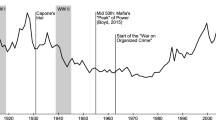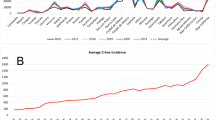Abstract
We provide a necessary and sufficient condition on the equilibrium of a Walrasian economy for an increase in police expenditure to induce an increase in crime. It turns out that this is essentially the condition for the Laffer curve to be downward sloping at a given ad valorem tax rate. Notably, such a perverse effect of police on crime is consistent with any appropriation technology and could arise even if the level of police protection is the socially optimal one.
Similar content being viewed by others
References
Auerbach, J.U.: Property rights enforcement with unverifiable incomes. Econ. Theory 68(3), 701–735 (2019)
Becker, G.: Crime and punishment: an economic approach. J. Polit. Econ. 76(2), 169–217 (1968)
Bindler, A., Hjalmarsson, R.: The impact of the first professional police forces on crime. J. Eur. Econ. Assoc. 19(6), 3063–3103 (2021)
Boyd, J.H., Jalal, A.M., Kim, J.: A general equilibrium investigation of handguns, cops and robbers. Econ. Theor. 33(3), 493–507 (2007)
Burdett, K., Lagos, R., Wright, R.: Crime, inequality, and unemployment. Am. Econ. Rev. 93(5), 1764–1777 (2003)
Burdett, K., Lagos, R., Wright, R.: An on-the-job search model of crime, inequality, and unemployment. Int. Econ. Rev. 45(3), 681–706 (2004)
Chalfin, A., McCrary, J.: Criminal deterrence: a review of the literature. J. Econ. Lit. 55(1), 5–48 (2017)
Chalfin, A., McCrary, J.: Are US cities underpoliced? Theory and evidence. Rev. Econ. Stat. 100(1), 167–186 (2018)
Dal Bó, E., Dal Bó, P.: Workers, warriors, and criminals: social conflict in general equilibrium. J. Eur. Econ. Assoc. 9(4), 646–677 (2011)
Di Tella, R., Schargrodsky, E.: Do police reduce crime? Estimates using the allocation of police forces after a terrorist attack. Am. Econ. Rev. 94(1), 115–133 (2004)
Draca, M., Machin, S., Witt, R.: Panic on the streets of London: police, crime, and the July 2005 terror attacks. Am. Econ. Rev. 101(5), 2157–2181 (2011)
Ehrlich, I.: Crime, punishment, and the market for offenses. J. Econ. Perspect. 10(1), 43–67 (1996)
Evans, W.N., Owens, E.G.: COPS and crime. J. Public Econ. 91(1–2), 181–201 (2007)
Garfinkel, M.R., Skaperdas, S.: Economics of conflict: an overview. Handb. Def. Econ. 2, 649–709 (2007)
Ghosh, A., Robertson, P.E.: Trade and expropriation. Econ. Theor. 50(1), 169–191 (2012)
Grossman, H.I.: Production, appropriation, and land reform. Am. Econ. Rev. 84(3), 705–712 (1994)
Klick, J., Tabarrok, A.: Using terror alert levels to estimate the effect of police on crime. J. Law Econ. 48(1), 267–279 (2005)
Lasso de la Vega, C., Volij, O., Weinschelbaum, F.: Theft in equilibrium. Eur. Econ. Rev. 139, 103869 (2021)
Levitt, S.D.: Using electoral cycles in police hiring to estimate the effects of police on crime. Am. Econ. Rev. 87(3), 270–290 (1997)
Levitt, S.D., Miles, T.J.: Economic contributions to the understanding of crime. Ann. Rev. Law Soc. Sci. 2, 147–164 (2006)
Marvell, T.B., Moody, C.E.: Specification problems, police levels, and crime rates. Criminology 34(4), 609–646 (1996)
Polinsky, A.M., Shavell, S.: The economic theory of public enforcement of law. J. Econ. Lit. 38(1), 45–76 (2000)
Usher, D.: Theft as a paradigm for departures from efficiency. Oxf. Econ. Pap. 39(2), 235–252 (1987)
Vásquez, J.: A theory of crime and vigilance. Am. Econ. J. Microecon. 14, 255–303 (2022)
Weisburd, S.: Police presence, rapid response rates, and crime prevention. Rev. Econ. Stat. 103(2), 280–293 (2021)
Author information
Authors and Affiliations
Corresponding author
Additional information
Publisher's Note
Springer Nature remains neutral with regard to jurisdictional claims in published maps and institutional affiliations.
We are grateful to Rafael Di Tella, Sebastian Galiani, Naomi Gershoni, Andrés Neumeyer, Ignacio Palacios-Huerta, two anonymous referees and the associate editor for useful comments. This research was supported by the Israel Science Foundation (research Grant 962/19). Lasso de la Vega and Volij also thank the Spanish Ministerio de Economía y Competitividad (Project PID2019-107539GB-I00) and the Gobierno Vasco (Project IT1697-22) for research support. An earlier version of this paper circulated under the title “Can more police induce more crime?”
Rights and permissions
Springer Nature or its licensor (e.g. a society or other partner) holds exclusive rights to this article under a publishing agreement with the author(s) or other rightsholder(s); author self-archiving of the accepted manuscript version of this article is solely governed by the terms of such publishing agreement and applicable law.
About this article
Cite this article
Lasso de la Vega, C., Volij, O. & Weinschelbaum, F. When do more police induce more crime?. Econ Theory 76, 759–778 (2023). https://doi.org/10.1007/s00199-022-01477-7
Received:
Accepted:
Published:
Issue Date:
DOI: https://doi.org/10.1007/s00199-022-01477-7




